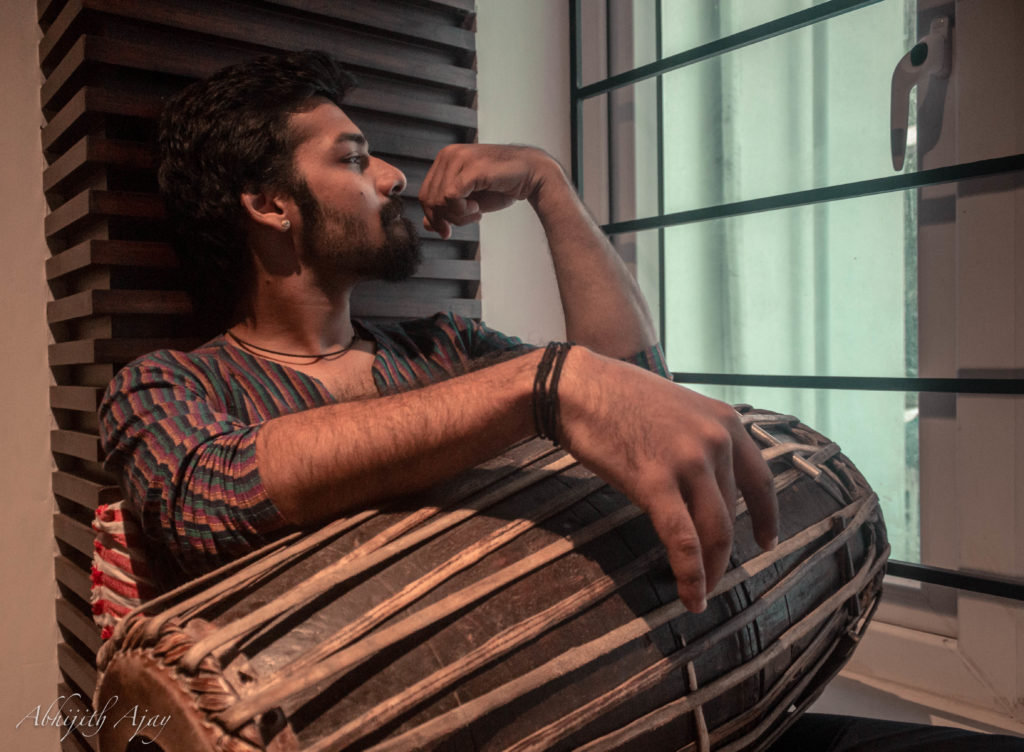Sumesh Narayanan

Bubbly, enthusiastic, cheerful – these describe multi-faceted Sumesh Seshadri Nath Narayanan to a T. As a vibrant mridangist, he has accompanied Bombay Jayashri, Abhishek Raghuram, S Sowmya, Sikkil Gurucharan and more. A key member of the fusion bands IndoSoul and Sparsh, he has also acted in the recently released movie, Sarvam Thaala Mayam, directed by Rajiv Menon with music by AR Rahman. He makes his own music and is releasing an EP soon. Besides all this, he designs bespoke furniture and hopes to open a woodworking studio by the end of the year.
Many thanks to Sri. Sumesh for sharing exclusive media for this page. A version of this article appeared in The Hindu.
As a rambunctious toddler, he accompanied his mother to her orchestral performances in Bombay, unfailingly gravitating to the percussion section. The family moved to Chennai soon where his mother insisted that her son accompany her to the many concerts she attended. He was a regular visitor at Ramani Dharmaraja’s, a neighbour, whose grandson was a good friend. Many concerts took place at Ramani’s backyard, the precursor to today’s Nayaki sabha. One such day was TV Sankaranarayanan’s concert. The usually restless Sumesh was entranced by the mridangist that day, putting talam throughout, not moving out of his seat. After the concert, the mridangist beckoned to 8-year-old Sumesh and asked him if he learned mridangam. Sumesh said no and that he learned vocal from his mother. “Call your mother,” he was told. She hurried in, totally flustered, apologising all the way for any ruckus her mischievous son might have caused. Her fears were immediately allayed and she was asked to bring him for lessons the very next day. That mridangist was Thiruvarur Bhaktavatsalam.
His first class was on July 8th, 2000. He would go to Bhaktavatsalam’s house every weekend at around 9 am and stay till 2 pm. Besides his own individual lesson, much time was spent observing other students being taught. The first three years were purely mechanical rudiments. “We begin with correct placement of hands and fingers on the head (of the mridangam) to train the muscles to involuntarily go there regardless of what the stroke is. The chaapu, for example, is the fundamental tonic note, set to madhya sthayi shadjam, but is a very nuanced movement. The pinky finger is critical but only as the fulcrum for the other three fingers to produce the sound – that takes a while to appreciate and understand. We then learn various talams, calculations and sarva laghu within talams, variations in different sol-kattus etc.”
Sumesh had to be pressed to practice and would do so only for a few minutes or just before the next class. “During summer vacations, I would be with Sir throughout.” In 2004, he entered advanced training. Delhi Sairam, mridangist, senior student of Bhaktavatsalam and a regular on the concert scene now, mentored Sumesh, getting him to listen to many recordings of other styles of mridangam. He had his arangetram in 2005. “I then did the competition circuit extensively. In 2007, I participated in 18 competitions and won the first prize in all 18. That got me a lot of exposure.”
Studying in St. John’s Besant Nagar, Sumesh was the only one in his class who played the mridangam while others were into guitar and keyboard. He got permission from the kind school Principal, Mrs. Ajitha Mathews, to use the bulk of his lunch period to practice on the school guitar. He was a fixture in all the school’s cultural programs and went caroling for several years.
Sumesh feels very strongly that one should grab every opportunity that comes one’s way without fear or trepidation. “We could fail whilst trying. But one should never say no to knowledge”. This attitude and exposure to other musics had significant bearing on his embracing participation in bands and other interesting collaborative opportunities. Karthick Iyer of IndoSoul says, “Besides mridangam, Sumesh is adept in Latin and Arabian percussion and the person we go to for any electronic music programming. He is a delight to watch for his amazing energy and how he gets into the music.”

Sumesh explains how he was intrigued by the Pandeiro, a Brazilian hand-held drum. “The chatusram (4 notes a beat) in Pandeiro sounds like Misram (3.5 notes a beat) in Carnatic.” Karthick adds, “Sumesh is a thinking musician – he merely has to hear a piece once to instantly figure out what and what not to play, where to hold back and where to give it his all. It is a rare quality which he has in abundance.” Sairam too applauds Sumesh’s ability to quickly absorb new aspects.
Ashwath Narayanan (no relation), Carnatic vocalist whom Sumesh has played for, says, “He brings in a great mix of artistic sensitivity, positive personality and unlimited energy making it most enjoyable to work with him.”
Just as Franco Zeffirelli seamlessly traversed directing theatre, opera and film, Sumesh Narayanan adroitly switches from accompanying to creating to discovering myriad forms of music and other arts.